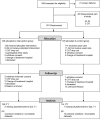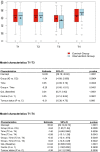The effects of an integrated supportive care intervention on quality of life outcomes in outpatients with breast and gynecologic cancer undergoing chemotherapy: Results from a randomized controlled trial
- PMID: 31115192
- PMCID: PMC6639168
- DOI: 10.1002/cam4.2196
The effects of an integrated supportive care intervention on quality of life outcomes in outpatients with breast and gynecologic cancer undergoing chemotherapy: Results from a randomized controlled trial
Abstract
The aim of the Complementary Nursing in Gynecologic Oncology study was to investigate the effects of a complex, nurse-led, supportive care intervention using Complementary and Integrative Medicine (CIM) on patients' quality of life (QoL) and associated patient-reported outcomes. In this prospective, pragmatic, bicentric, randomized controlled trial, women with breast or gynecologic cancer undergoing a new regimen of chemotherapy (CHT) were randomly assigned to routine supportive care plus intervention (intervention group, IG) or routine care alone (control group, CG). The intervention consisted of CIM applications and counseling for symptom management, as well as CIM information material. The primary endpoint was global QoL measured with the EORTC-QLQ-C30 before and after CHT. Mixed linear models considering fixed and random factors were used to analyze the data. In total, 126 patients were randomly assigned into the IG and 125 patients into the CG (median age 51 years). The patients' medical and socio-demographic characteristics were homogenous at baseline and at follow-up. No group effects on QoL were found upon completion of CHT (estimate -1.04 [-4.89; 2.81]; P = 0.596), but there was a significant group difference in favor of the IG 6 months later (estimate 6.643 [1.65; 11.64]; P = 0.010). IG patients did also experience significant better emotional functioning (P = 0.007) and less fatigue (P = 0.027). The tested supportive intervention did not improve patients' QoL outcomes directly after CHT (T3), but was associated with significant QoL improvements when considering the change from baseline to the time point T4, which could be assessed 6 months after patients' completion of CHT. This delayed effect may have resulted due to a strengthening of patients' self-management competencies.
Keywords: breast cancer; chemotherapy; complementary therapies; gynecologic cancer; health services research; nursing intervention; patient-reported outcomes; quality of life; self-care; supportive care.
© 2019 The Authors. Cancer Medicine published by John Wiley & Sons Ltd.
Conflict of interest statement
None declared.
Figures


References
-
- Bonacchi A, Toccafondi A, Mambrini A, et al. Complementary needs behind complementary therapies in cancer patients. Psychooncology. 2015;24:1124‐1130. - PubMed
-
- Groenvold M, Fayers PM, Petersen MA, Mouridsen HT. Chemotherapy versus ovarian ablation as adjuvant therapy for breast cancer: impact on health‐related quality of life in a randomized trial. Breast Cancer Res Treat. 2006;98:275‐284. - PubMed
-
- Klafke N, Eliott JA, Wittert GA, Olver IN. Prevalence and predictors of complementary and alternative medicine (CAM) use by men in Australian cancer outpatient services. Ann Oncol. 2012;23:1571‐1578. - PubMed
Publication types
MeSH terms
Associated data
LinkOut - more resources
Full Text Sources
Medical

